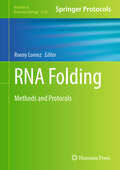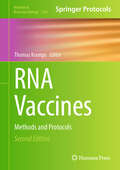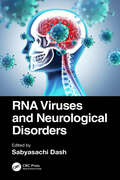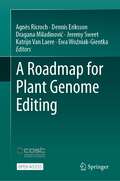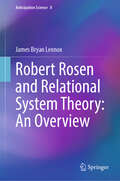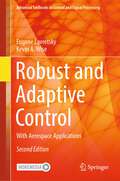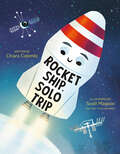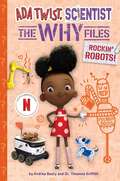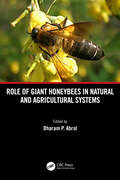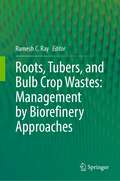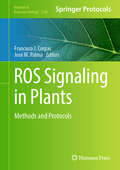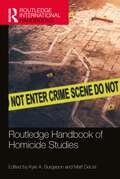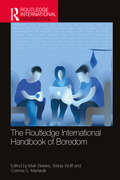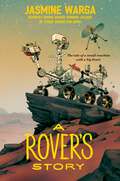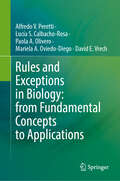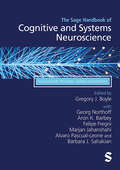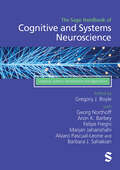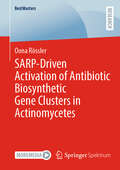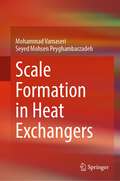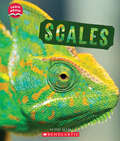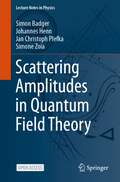- Table View
- List View
RNA Folding: Methods and Protocols (Methods in Molecular Biology #2726)
by Ronny LorenzTo understand and predict the behavior and function of RNAs, sophisticated tools are required to simulate and analyze their potential for forming structures. This volume discusses the various levels of prediction and algorithmic approaches to RNA folding. The chapters in this book cover topics such as energy parameters of the nearest-neighbor (NN) energy model; classified dynamic programming to address exponential growth of candidate structures that an RNA molecule may fold into; sequence evolution and conserved structures among multiple RNA sequences; the latest framework capable of handling both positive and negative RNA sequence design objectives; and kinetic folding approaches that look at the dynamic nature of RNA folding. Written in the highly successful Methods in Molecular Biology series format, chapters include introductions to their respective topics, lists of the necessary materials and reagents, step-by-step, readily reproducible laboratory protocols, and tips on troubleshooting and avoiding known pitfalls. Cutting-edge and comprehensive, RNA Folding: Methods and Protocols is a valuable resource for researchers who are interested in learning more about this important and developing field.
RNA Vaccines: Methods and Protocols (Methods in Molecular Biology #2786)
by Thomas KrampsThis second edition volume expands on the previous edition with discussions of the latest technology and advancements in the development of RNA vaccines and proposed solutions on how to tackle currently unmet medical needs. The chapters in this book are organized into four parts and cover topics such as replication and non-replicating RNA vectors, formulation and delivery of RNA vaccines, and clinical and nonclinical development of RNA vaccines. Written in the highly successful Methods in Molecular Biology series format, chapters include introductions to their respective topics, lists of the necessary materials and reagents, step-by-step, readily reproducible laboratory protocols, and tips on troubleshooting and avoiding known pitfalls.Practical and comprehensive, RNA Vaccines: Methods and Protocols, Second Edition is a valuable resource for any researcher interested in learning more about this important and developing field.
RNA Viruses and Neurological Disorders
by Sabyasachi DashThis volume is an accessible introduction to RNA viruses and the infectious outcomes that they cause in the central nervous system (CNS). Chapters cover the major RNA viruses, their impact on the CNS, and the similarities and differences in pathological outcomes that can be observed. Neuroscientists, be they students, researchers, or clinicians, will benefit from the timely coverage provided. Our understanding of viruses, and specifically RNA viruses and their pathological impact, is rapidly evolving. For example, the close molecular interaction of viruses with the CNS cell types in the human host is poorly understood. Readers can use the book to understand clearly the cellular and molecular mechanisms governing pathological outcomes of RNA virus infection in the cell types of the human brain (e.g., neurons, endothelial cells, astrocytes, resident immune cells) based on summarized case studies, and gain insight into how cell type-specific defects affect brain function and cause poor clinical outcomes. The book is aimed primarily at neuroscience students and postgraduates wishing to learn about virology and professionals who are interested to learn more about virus-associated neuropathology. A basic knowledge of cell and molecular biology is assumed; however, readers across the disciplines of science, technology, engineering, and mathematics will find this topical and timely publication of value.
A Roadmap for Plant Genome Editing
by Agnès Ricroch Dennis Eriksson Dragana Miladinović Jeremy Sweet Katrijn Van Laere Ewa Woźniak-GientkaThis open access book is an update of genome editing techniques applied to a range of plants. We discuss the latest techniques and applications to cereals, roots and tubers, oilseed crops, fruit and forest trees, vegetables, legumes and algae including resistance to biotic and abiotic stresses, improved quality, drug production, yield and adaptation to climate change. The regulations in different countries worldwide, the patentibility and the perception by society of the applications of new genomic techniques are examined. This book is written by a multidisciplinary and multisectoral collective of high-profile scientists and other experts belonging to the COST Action network PlantEd, which is mainly European but with contributions from American, Australian, Canadian, Chinese, Indian, Iranian, Pakistani and Peruvian scientists. The book is aimed at a wide audience consisting of students, academics, private and public breeders, other actors in the food and bioeconomy value chains and policy and law makers.This is an open access book.
Robert Rosen and Relational System Theory: An Overview (Anticipation Science #8)
by James Bryan LennoxThis book focuses on Robert Rosen’s contributions to relational system theory, which is the science of organization and function. This science was originally developed by Nicolas Rashevsky, and further developed by Rashevsky’s student Robert Rosen, and continues to be developed by Rosen’s student A. H. Louie amongst others. Due to its revolutionary character, it is often misunderstood, and to some, controversial. The formal and conceptual setting for Rosen’s relational system theory is category theory. Rosen was the first to apply category theory to scientific problems, outside of pure mathematics, and the first to think about science from the point of view of category theory. To better understand the work of Rosen, this book provides an overview of his theory of modeling, complexity, anticipation, and organism. It presents the foundations of this science and the philosophical motivations behind it along with conceptual clarification and historical context in order to present Rosen’s ideas to a wider audience.
Robust and Adaptive Control: With Aerospace Applications (Advanced Textbooks in Control and Signal Processing)
by Eugene Lavretsky Kevin A. WiseRobust and Adaptive Control (second edition) shows readers how to produce consistent and accurate controllers that operate in the presence of uncertainties and unforeseen events. Driven by aerospace applications, the focus of the book is primarily on continuous-time dynamical systems.The two-part text begins with robust and optimal linear control methods and moves on to a self-contained presentation of the design and analysis of model reference adaptive control for nonlinear uncertain dynamical systems. Features of the second edition include:sufficient conditions for closed-loop stability under output feedback observer-based loop-transfer recovery (OBLTR) with adaptive augmentation;OBLTR applications to aerospace systems;case studies that demonstrate the benefits of robust and adaptive control for piloted, autonomous and experimental aerial platforms;realistic examples and simulation data illustrating key features of the methods described; andproblem solutions for instructors and MATLAB® code provided electronically.The theory and practical applications address real-life aerospace problems, being based on numerous transitions of control-theoretic results into operational systems and airborne vehicles drawn from the authors’ extensive professional experience with The Boeing Company. The systems covered are challenging—often open-loop unstable with uncertainties in their dynamics—and thus require both persistently reliable control and the ability to track commands either from a pilot or a guidance computer.Readers should have a basic understanding of root locus, Bode diagrams, and Nyquist plots, as well as linear algebra, ordinary differential equations, and the use of state-space methods in analysis and modeling of dynamical systems. The second edition contains a background summary of linear systems and control systems and an introduction to state observers and output feedback control, helping to make it self-contained.Robust and Adaptive Control teaches senior undergraduate and graduate students how to construct stable and predictable control algorithms for realistic industrial applications. Practicing engineers and academic researchers will also find the book of great instructional value.
Rocket Ship, Solo Trip
by Chiara ColombiA delightful, rhyming picture book that is perfect for fans of Goodnight, Goodnight, Construction Site and captures all the excitement and nervousness of life's big firsts; art by New York Times bestselling illustrator, Scott Magoon!&“First time jitters? That&’s okay.Find one small step to lead the way.&”Rocket is embarking on her first solo mission. Her goal? Place a satellite into orbit to take pictures of the beautiful unknown. With a few words of encouragement from Ground Control, Rocket sparks ignition and blasts off to discover all the beauty of outer space. But when it&’s time for reentry, she wonders if she can do it alone. With Ground Control&’s parting words in mind, Rocket trusts that she knows exactly what to do. She returns home at hypersonic speed and excited for her future expeditions…maybe next time, to the moon.With delightful rhyming stanzas, and pictures by New York Times bestselling illustrator Scott Magoon, Rocket Ship, Solo Trip explores all the complicated emotions of big firsts and reminds readers that no matter how far they go, the ones they love are always close by.
Rockin' Robots! (Questioneers)
by Andrea Beaty Theanne GriffithNew York Times bestselling author Andrea Beaty and neuroscientist Theanne Griffith’s Rockin’ Robots is the fifth book in a nonfiction early-reader series about the science of robots starring Ada Twist, Scientist! <P><P> What exactly is a robot? How do they talk and move? And what does it take to build one? Ada Twist, Scientist: The Why Files is the perfect nonfiction resource for all these questions and more. Based on the bestselling Questioneers series and the Ada Twist, Scientist Netflix show, this nonfiction series is perfect for the youngest scientists of tomorrow as they learn along with Ada. Designed in a scrapbook format, these books combine art from the show, illustrations, and photography to bring simple science concepts to life. Check out all the books in the Questioneers Series: The Questioneers Picture Book Series: Iggy Peck, Architect | Rosie Revere, Engineer | Ada Twist, Scientist | Sofia Valdez, Future Prez | Aaron Slater, Illustrator | Lila Greer, Teacher of the Year The Questioneers Chapter Book Series: Rosie Revere and the Raucous Riveters | Ada Twist and the Perilous Pants | Iggy Peck and the Mysterious Mansion | Sofia Valdez and the Vanishing Vote | Ada Twist and the Disappearing Dogs | Aaron Slater and the Sneaky Snake The Questioneers: The Why Files Series: Exploring Flight! | All About Plants! | The Science of Baking | Bug Bonanza! | Rockin’ Robots! The Questioneers: Ada Twist, Scientist Series: Ghost Busted | Show Me the Bunny | 5-Minute Ada Twist, Scientist Stories | Ada Twist, Scientist: Brainstorm Book The Questioneers Big Project Book Series: Iggy Peck’s Big Project Book for Amazing Architects | Rosie Revere’s Big Project Book for Bold Engineers | Ada Twist’s Big Project Book for Stellar Scientists | Sofia Valdez’s Big Project Book for Awesome Activists | Aaron Slater’s Big Project Book for Astonishing Artists
The Role of Fuels in Transforming Energy End-Use in Buildings and Industrial Processes (Synthesis Lectures on Engineering, Science, and Technology)
by Praveen Cheekatamarla Kyle Gluesenkamp Stephen Kowalski Zhenning Li Saad JajjaEnergy-efficient technologies are necessary to lower the carbon footprint for a transition towards clean energy in a sustainable manner. This book examines what role fuels have in the transformation of end-use in buildings and industrial processes. Energy-efficient technologies are necessary to lower the carbon footprint for a transition towards clean energy in a sustainable manner. Efficient utilization of primary energy resources, including renewables, to support the current and future energy needs while targeting grid resiliency, energy, and environmental security at an affordable cost is of significant value. The author analyzes heat pumps, fuel-driven thermal providers, and power systems configurations and looks at the sensitivity of the electrical grid's carbon intensity and tariff towards carbon footprint and energy costs compared with fuel-driven technologies. The role of low-carbon, zero-carbon, and carbon-negative fuels, such as power-to-gas (P2G), power-to-liquid (PtL), hydrogen, and biogas, in conjunction with polygeneration technologies, are discussed. This book also examines two different scenarios focused on the sensitivity of the pace of decarbonization of the electrical grid and fuel supply on operational energy-related carbon emissions.Compares electricity versus fuel as a primary energy sourceExplores the role of fuels in the decarbonization journey Examines the value proposition of currently available energy solutions
Role of Giant Honeybees in Natural and Agricultural Systems
by Dharam P. AbrolRole of Giant Honeybees in Natural and Agricultural Systems provides multidisciplinary perspective about the different facets of giant honeybees. Giant honeybees–Apis dorsata and Apis laboriosa are excellent pollinators of crops, fruits, and vegetables in cultivated and natural lanscapes. Their large size, long foraging range, and large work force make them the most spectacular of all honeybee species for crop pollination and honey production. Due to their decline, ecosystems and global food security are being threatened. This book is the first of its kind which deals in detail on varied aspects of giant honeybee biology, management, conservation strategies for protecting biodiversity and enhancing crop productivity. It aims to promote a large, diverse, sustainable, and dependable bee pollinator workforce that can meet the challenge for optimizing food production in 21st century. SALIENT FEATURES: Covers the latest information on various aspects of biology of giant honeybees and brings the latest advances together in a single volume for researchers and advanced level students Provides an excellent source of advanced study material for academics, researchers and students and programme planners Provides an excellent source of livelihood in mountainous areas and marginal farmers Deals with biology, management and conservation strategies for protecting biodiversity and enhancing crop productivity. Excellent pollinator of tropical and subtropical crops, fruits, vegetables, etc. less prone to diseases and enemies This book will be useful for pollination biologists, honeybee biologists, scientists working in agriculture, animal behavior, conservation, biology, ecology, entomologists, environmental biologists, etc.
Roots, Tubers, and Bulb Crop Wastes: Management by Biorefinery Approaches
by Ramesh C. RayThis edited book brings forth comprehensive information on the bioprocessing and biovalorization of root (i.e., cassava, sweet potato, yams, and aroids), tuber (i.e., potato, carrot, turnip, artichoke and beet root), and bulb (i.e., onion and garlic) crop wastes into various products and platform chemicals in a biorefinery approach. The non-edible portion of roots, tubers, and bulb crops, after processing (waste), such as peels, skins, pulps, rejects, and unmarketable tubers, account for about 20–40% of the total weight of the fresh produce. Tropical tuber crops such as cassava, yams, aroids, and sweet potato generate bagasse, the byproduct of the starch processing industry, which contains about 30–50% starch and fibrous materials on a dry weight basis. Similarly, the husk is the leading waste from onion and garlic processing. The amount of waste and byproducts of potato industry is estimated to be around 12–20% of their total production. These wastes pose increasing disposal and potentially severe pollution problems and represent a loss of valuable biomass and nutrients. Roots, tubers, and bulb wastes usually have a composition of sugar, starch, proteins, phenolic phytochemicals, fibers, and minerals. Therefore, they should not be considered as “wastes” but raw materials for other industrial processes in the biorefinery approach. These wastes provide conditions amenable for the growth of microorganisms and opens up great opportunities for their reuse in fermentation processes to develop value-added bioproducts such as enzymes, single-cell proteins, bio-absorbents, phenolic bioactive compounds, aroma and flavor compounds, organic acids, and biofuels. This book fills the gap in literature about the processes and by-products. The book is composed of 16- chapters deep diving into valorization and bioprocessing of a range of tuber crop waste. The book explores these processes in 11 different crops and highlights the life cycle assessment as well as highlightsthe opportunities about commercialization of technologies used in bioprocessing and bio-valorization of root crop waste. The processes explained in the book are rooted in the principles of circular economy. This book is of interest to teachers, researchers, environmentalists, bio-based industrialist, and policymakers.
ROS Signaling in Plants: Methods and Protocols (Methods in Molecular Biology #2798)
by Francisco J. Corpas José M. PalmaThis detailed volume presents methodologies for studying reactive oxygen species (ROS) metabolism in plant cells, including techniques for detecting different types of ROS such as superoxide radicals, hydrogen peroxide or singlet oxygen, as well as ROS generating systems such as xanthine oxidoreductase. The book provides alternatives to determine malondialdehyde, electrochemical detection approaches for determining total antioxidant capacity (TAC) as well as enzymatic antioxidants, as well as methods for studying non-enzymatic antioxidants and some components of the secondary metabolism. Written for the highly successful Methods in Molecular Biology series, the chapters in this book provide the kind of detailed implementation advice that leads to ideal results in the laboratory. Authoritative and practical, ROS Signaling in Plants: Methods and Protocols serves as an ideal guide for scientists interested in the metabolism of ROS in plant cells.
Routledge Handbook of Homicide Studies (Routledge International Handbooks)
by Kyle A. Burgason Matt DeLisiThe Routledge Handbook of Homicide Studies comprehensively examines the topic of homicide from a diverse collection of perspectives and backgrounds. It brings together original contributions on homicide, with a focus on the broad range of impacts of homicide from a multitude of disciplines that evaluate and examine homicide in actual practice and theory. The editors have assembled a comprehensive collection highlighting the multifaceted causes and ramifications of homicide both across the United States and globally, with chapters exploring the current state of homicide, typologies of homicides offenders, causes and correlates of homicide, homicides and the criminal justice system, and a professional observations chapters authored by some of the leading practicing professionals in the world, many of whom have made pivotal contributions to the evaluation and investigation of homicide offenders and cases. Providing state-of-the-art scholarship on homicide in modern society, this handbook is a key collection and an invaluable resource for students, researchers, and practitioners engaged in the study of homicide across a diverse range of disciplines, including criminal justice and criminology, psychology, sociology, forensics, interdisciplinary departments, and sociolegal studies.
Routledge Handbook of Homicide Studies (Routledge International Handbooks)
by Kyle A. Burgason Matt DeLisiThe Routledge Handbook of Homicide Studies comprehensively examines the topic of homicide from a diverse collection of perspectives and backgrounds. It brings together original contributions on homicide, with a focus on the broad range of impacts of homicide from a multitude of disciplines that evaluate and examine homicide in actual practice and theory. The editors have assembled a comprehensive collection highlighting the multifaceted causes and ramifications of homicide both across the United States and globally, with chapters exploring the current state of homicide, typologies of homicides offenders, causes and correlates of homicide, homicides and the criminal justice system, and a professional observations chapters authored by some of the leading practicing professionals in the world, many of whom have made pivotal contributions to the evaluation and investigation of homicide offenders and cases. Providing state-of-the-art scholarship on homicide in modern society, this handbook is a key collection and an invaluable resource for students, researchers, and practitioners engaged in the study of homicide across a diverse range of disciplines, including criminal justice and criminology, psychology, sociology, forensics, interdisciplinary departments, and sociolegal studies.
The Routledge International Handbook of Boredom (Routledge International Handbooks)
by Maik Bieleke Wanja Wolff Corinna S. MartarelliThis comprehensive text is a unique handbook dedicated to research on boredom. The book brings together leading contributors from across three continents and numerous fields to provide an interdisciplinary exploration of boredom, its theoretical underpinnings, its experiential properties, and the applied contexts in which it occurs.Boredom is often viewed as a mental state with little utility, though recent research suggests that it can be a powerful motivator of human behavior that shapes our actions in many ways. The book examines boredom from a range of perspectives and is comprised of three parts. Part I delves into the theoretical approaches to boredom, presenting methods for its measurement, explaining when and why boredom occurs, and scrutinizing the impact it has on our behavior. Part II focuses on the psychological and neural properties of boredom and its associations with a multitude of mental and interpersonal processes, such as self-control, mind-wandering, flow, and aggression. Part III presents boredom in practical contexts like school and work, and sheds light on its role for health-related behaviors, psychosocial well-being, and aesthetic experiences. The book concludes by summarizing the state of boredom research, identifying promising areas for future research, and providing directions for how research on boredom can be advanced. As the authoritative book on boredom, this handbook is an essential resource for students and researchers of psychology, sociology, education, sport science, and computer science.
A Rover's Story
by Jasmine WargaNew York Times bestseller * Best Book of the Year from The Washington Post, Publishers Weekly, New York Public Library, Chicago Public LibraryThe One and Only Ivan meets The Wild Robot in this unique and deeply moving middle grade novel about the journey of a fictional Mars rover, from the Newbery Honor–winning author of Other Words for Home. Meet Resilience, a Mars rover determined to live up to his name.Res was built to explore Mars. He was not built to have human emotions. But as he learns new things from the NASA scientists who assemble him, he begins to develop humanlike feelings. Maybe there’s a problem with his programming….Human emotions or not, launch day comes, and Res blasts off to Mars, accompanied by a friendly drone helicopter named Fly. But Res quickly discovers that Mars is a dangerous place filled with dust storms and giant cliffs. As he navigates Mars’s difficult landscape, Res is tested in ways that go beyond space exploration.As millions of people back on Earth follow his progress, will Res have the determination, courage, and resilience to succeed… and survive?
Rules and Exceptions in Biology: from Fundamental Concepts to Applications
by Alfredo V. Peretti Lucía S. Calbacho-Rosa Paola A. Olivero Mariela A. Oviedo-Diego David E. VrechThis is the first book to cover and explore the rules and exceptions in biology. It presents past and current perspectives on the subject and discusses the various situations of transition from rule to exception and vice versa. In doing so, the book fills a gap in the scientific literature and stimulates useful and valuable discussions among researchers working in biology worldwide. The chapters begin with a theoretical framework, followed by the main topic(s) or question(s), and a summary of previous work on the topic. Examples are discussed, with concluding remarks and suggestions for future research. A section with key concepts is included at the end of each chapter, allowing the reader to jump directly to the most important findings or observations. Each chapter is written to be used as a reference by graduate students and professionals from a variety of scientific disciplines (e.g. behavior, ecology, evolution, and systematics).
The Sage Handbook of Cognitive and Systems Neuroscience: Neuroscientific Principles, Systems and Methods
by Gregory J. Boyle Georg Northoff Aron K. Barbey Felipe Fregni Marjan Jahanshahi Alvaro Pascual-Leone Barbara J. SahakianCognitive neuroscience is the interdisciplinary study of how cognitive and intellectual functions are processed and represented within the brain, which is critical to building understanding of core psychological and behavioural processes such as learning, memory, behaviour, perception, and consciousness. Understanding these processes not only offers relevant fundamental insights into brain-behavioural relations, but may also lead to actionable knowledge that can be applied in the clinical treatment of patients with various brain-related disabilities. This Handbook focusses on the foundational principles, methods, and underlying systems in cognitive and systems neuroscience, as well as examining cutting-edge methodological advances and innovations. Containing 34 original, state of the art contributions from leading experts in the field, this Handbook is essential reading for researchers and students of cognitive psychology, as well as scholars across the fields of neuroscientific, behavioural and health sciences. Part 1: Background Considerations Part 2: Neuroscientific Substrates and Principles Part 3: Neuroanatomical Brain Systems Part 4: Neural Dynamics and Processes Part 5: Sensory-Perceptual Systems and Cognition Part 6: Methodological Advances
The Sage Handbook of Cognitive and Systems Neuroscience: Neuroscientific Principles, Systems and Methods
by Gregory J. Boyle Georg Northoff Aron K. Barbey Felipe Fregni Marjan Jahanshahi Alvaro Pascual-Leone Barbara J. SahakianCognitive neuroscience is the interdisciplinary study of how cognitive and intellectual functions are processed and represented within the brain, which is critical to building understanding of core psychological and behavioural processes such as learning, memory, behaviour, perception, and consciousness. Understanding these processes not only offers relevant fundamental insights into brain-behavioural relations, but may also lead to actionable knowledge that can be applied in the clinical treatment of patients with various brain-related disabilities. This Handbook focusses on the foundational principles, methods, and underlying systems in cognitive and systems neuroscience, as well as examining cutting-edge methodological advances and innovations. Containing 34 original, state of the art contributions from leading experts in the field, this Handbook is essential reading for researchers and students of cognitive psychology, as well as scholars across the fields of neuroscientific, behavioural and health sciences. Part 1: Background Considerations Part 2: Neuroscientific Substrates and Principles Part 3: Neuroanatomical Brain Systems Part 4: Neural Dynamics and Processes Part 5: Sensory-Perceptual Systems and Cognition Part 6: Methodological Advances
The Sage Handbook of Cognitive and Systems Neuroscience: Cognitive Systems, Development and Applications
by Gregory J. Boyle Georg Northoff Aron K. Barbey Felipe Fregni Marjan Jahanshahi Alvaro Pascual-Leone Barbara J. SahakianCognitive neuroscience is the interdisciplinary study of how cognitive and intellectual functions are processed and represented within the brain, which is critical to building understanding of core psychological and behavioural processes such as learning, memory, behaviour, perception, and consciousness. Understanding these processes not only offers relevant fundamental insights into brain-behavioural relations, but may also lead to actionable knowledge that can be applied in the clinical treatment of patients with various brain-related disabilities. This Handbook examines complex cognitive systems through the lens of neuroscience, as well as providing an overview of development and applications within cognitive and systems neuroscience research and beyond. Containing 35 original, state of the art contributions from leading experts in the field, this Handbook is essential reading for researchers and students of cognitive psychology, as well as scholars across the fields of neuroscientific, behavioural and health sciences. Part 1: Attention, Learning and Memory Part 2: Language and Communication Part 3: Emotion and Motivation Part 4: Social Cognition Part 5: Cognitive Control and Decision Making Part 6: Intelligence
The Sage Handbook of Cognitive and Systems Neuroscience: Cognitive Systems, Development and Applications
by Gregory J. Boyle Georg Northoff Aron K. Barbey Felipe Fregni Marjan Jahanshahi Alvaro Pascual-Leone Barbara J. SahakianCognitive neuroscience is the interdisciplinary study of how cognitive and intellectual functions are processed and represented within the brain, which is critical to building understanding of core psychological and behavioural processes such as learning, memory, behaviour, perception, and consciousness. Understanding these processes not only offers relevant fundamental insights into brain-behavioural relations, but may also lead to actionable knowledge that can be applied in the clinical treatment of patients with various brain-related disabilities. This Handbook examines complex cognitive systems through the lens of neuroscience, as well as providing an overview of development and applications within cognitive and systems neuroscience research and beyond. Containing 35 original, state of the art contributions from leading experts in the field, this Handbook is essential reading for researchers and students of cognitive psychology, as well as scholars across the fields of neuroscientific, behavioural and health sciences. Part 1: Attention, Learning and Memory Part 2: Language and Communication Part 3: Emotion and Motivation Part 4: Social Cognition Part 5: Cognitive Control and Decision Making Part 6: Intelligence
SARP-Driven Activation of Antibiotic Biosynthetic Gene Clusters in Actinomycetes (BestMasters)
by Oona RösslerActinomycetes are a group of Gram-positive bacteria of which many representatives are prominent for being prolific producers of bioactive natural products including antibiotics, fungicides, antitumor agents, or immunosuppressants. SARP transcriptional regulators are widely distributed among actinomycetes, especially in streptomycetes and are known to activate antibiotic biosynthesis. The set of genes responsible for the production of natural products, including pathway specific transcriptional regulators such as SARPs, are typically located in contiguous regions of the genome known as "biosynthetic gene clusters" (BGCs). In this book, Oona Rössler reports on the activation of antibiotic BGCs in selected actinomycetes strains upon heterologous expression of the SARP-type regulator PapR2 from Streptomyces pristinaespiralis. Applying a bioinformatic screening for the abundance of SARP genes and SARP consensus sequences as part of BGCs, the author has selected actinomycetes candidate strains from the DSMZ strain collection for heterologous SARP expression. It is shown that overexpression of papR2 increased the production of predominantly unknown antimicrobial compounds in more than half of the selected actinomycetes strains, as observed by bioassays against different microbial test strains including bacteria and fungi.
Scale Formation in Heat Exchangers
by Mohammad Varnaseri Seyed Mohsen PeyghambarzadehThis book brings together a wide range of current research to create a holistic understanding of fouling. It draws upon practical and laboratory experiences spanning many years. While offering an overview of various fouling types, the book's emphasis is on crystallization fouling, a facet seldom addressed in the existing literature. Furthermore, this book goes beyond theory by providing practical examples for heat exchanger design, incorporating the pivotal consideration of fouling's impact. It focuses especially on calcium salts such as calcium carbonate and calcium sulfate.Fouling formation represents a ubiquitous challenge across diverse industrial sectors, spanning oil, gas, petrochemicals, food, pharmaceuticals, and power generation. This encroaching fouling, prevalent within heating equipment, not only jeopardizes the integrity of machinery but also significantly saps energy resources. Consequently, extensive research efforts have been undertaken to comprehensively explore fouling formation through both experimental and theoretical avenues across various heating apparatuses. The book's mission is to facilitate a broader comprehension of crystallization fouling research, revealing the various factors influencing this form of fouling. Additionally, it critiques prior research endeavors, identifying their strengths and weaknesses while pinpointing potential avenues for future investigation
Scales (Learn About)
by Eric GeronLet's learn all about the different types of animal coverings!Which animals have scales? Fish! Did you know that some birds, reptiles, and mammals can also have scales? Discover all the incredible ways scales help animals survive. With amazing photos and lively text, this book explains how scales help animals stay warm or cool, move, protect themselves, and more! Get ready to learn all about scales!ABOUT THE SERIES:Animals have different body coverings for different reasons. Some animals use their coverings to keep warm or stay cool, others use them for protection, and can either stand out or blend in. Some animals even use their coverings to move! This vibrant new set of Learn About books gives readers a close-up look at five different animal coverings, from fur and feathers to skin, scales, and shells. Each book is packed with photographs and fun facts that explore how each covering suits the habitat, diet, survival, and life cycle of various animals in the natural world.
Scattering Amplitudes in Quantum Field Theory (Lecture Notes in Physics #1021)
by Simon Badger Johannes Henn Jan Christoph Plefka Simone ZoiaThis open access book bridges a gap between introductory Quantum Field Theory (QFT) courses and state-of-the-art research in scattering amplitudes. It covers the path from basic definitions of QFT to amplitudes, which are relevant for processes in the Standard Model of particle physics. The book begins with a concise yet self-contained introduction to QFT, including perturbative quantum gravity. It then presents modern methods for calculating scattering amplitudes, focusing on tree-level amplitudes, loop-level integrands and loop integration techniques. These methods help to reveal intriguing relations between gauge and gravity amplitudes and are of increasing importance for obtaining high-precision predictions for collider experiments, such as those at the Large Hadron Collider, as well as for foundational mathematical physics studies in QFT, including recent applications to gravitational wave physics.These course-tested lecture notes include numerous exercises with solutions. Requiring only minimal knowledge of QFT, they are well-suited for MSc and PhD students as a preparation for research projects in theoretical particle physics. They can be used as a one-semester graduate level course, or as a self-study guide for researchers interested in fundamental aspects of quantum field theory.
